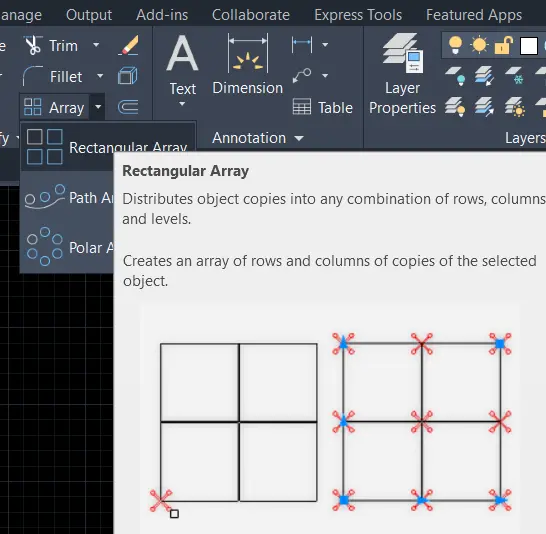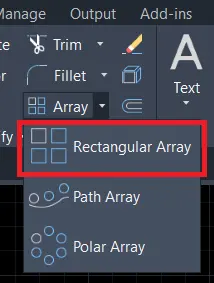Hey Guys, Earlier we learned the Fillet command from the modified panel. Today we are learning about Rectangular Array and How to use this command in AutoCAD. What is the difference between Copy and Array?
This command has three parts. We will learn the Rectangular Array command which is the first command from the Array command. So, let’s get started.
Do you know How to use the Rectangular Array command in AutoCAD?
The moves toward making a rectangular array are given beneath:

1. Open the AutoCAD programming software.
2. Click Home tab >> Modify panel board>> Rectangular Array.
3. Select the objects to array & press Enter. A default rectangular array is shown.
4. On the array see, drag the holds to change the separating and number of lines & segments. You can likewise alter values on the Array setting strip.
To Add Levels to a Rectangular Array
a) Select one of the things in the array.
b) In Array setting strip Levels board Levels
c) Enter the number of levels.
We can invoke the rectangular array command from the Array command drop-down menu in the Modify panel in the Home tab.
Or we can type ‘ARRAYRECT’ in the command bar and press the Enter key.
The object must be already drawn for the use array command.
After invoking the command, it will ask for ‘select object’.
Select the object and right-click.
What is a Rectangular Array in AutoCAD?

The rectangular array command is called the arrangement of the object into rows, columns, and levels that form a rectangle.
We can create multiple copies of an object in the form of a rectangle using this command in AutoCAD.
The Array command is very useful for distributing evenly copies of the object along with row, column, any path, or circular path.
This command is a very time–saving command.
This command is placed on the Modify panel in the “Home tab”.
Or we can type ‘ARRAY’ in the command bar and press the Enter key to invoke the array command.
Array command has three methods to evenly copy the object.
We can select another two methods of the Array by clicking on the Array command’s drop–down menu.
It is necessary to already draw any object to use the Array command.
We will see all three methods with examples one by one.
The Rectangular array distributes copies of the selected object in rows and columns in rectangular shapes evenly.
The object will copy automatically in a Rectangular shape as shown.
Modify Row, Column & Space of Rectangular Array
There are two methods to change the numbers of rows and columns and change the space between rows and columns
The first method of Rectangular Array
After right-clicking, the object will be copied in a rectangular shape, and one panel will be open at the top of the workspace as shown.

We can add/subtract numbers of rows and columns and can change the space between two rows and columns from this panel.
By default, we can select the entire copied array by clicking on one array.
But if we want to separate the entire array then click on ‘Associative’.
It will separate the entire copied array.
We can also change ‘Basepoint’ from this panel.
Click on the base point and select the object point that you want as a base point.
The second method of Rectangular Array
After right-clicking, the object will see your object will copy in a rectangular shape, and then we can see some dots in the objects as shown.

Select the upper right corner object dot and drag it.
By dragging on the right side it will add columns and by dragging the upper side, it will add rows.
Similarly dragging at the opposite side, will subtract rows and columns.
By selecting and dragging the upper left corner object point, it will add/subtract the numbers of rows and columns on the left side as the same as on the right side.
Increase/Decrease in-between space
To increase space between column spaces, select a triangular dot point at the lower row and drag it.
For increase/decrease space between rows, select a rectangular point at the middle row pointed at the upper side. And drag it.
Edit Source
We can edit the source that we first drew.
Close the array for the first time and select again all copied arrays.
One new panel will open with some new options as shown.

Select ‘Edit source’ from there.
Then it will ask ‘Select an object in the array’.
Select the object which we want as a new source object.
Click on OK.
Replace Item
For example, if we want to replace the rectangle instead of a circle, then click on ‘Replace item’.
Then it will ask for ‘select replacement object’.
Select the newly drawn object (rectangle) and right-click.
Then it will ask for ‘select base point of replacement objects.
Select any base point as per the requirement of a newly drawn object (the center point of a rectangle).
At last, it will ask for ‘Select an item in the array to replace.
Select those objects (circles) which we want to replace as shown.

FAQ on Rectangular Array
In AutoCAD, the copy command is used to “copy” the elements or objects in an order defined by us. In contrast, the array command is used to copy the objects with predefined angles and numbers in a fixed order (Rectangular/Polar/Path array).
There are three types of arrays, see below:
a) Rectangular Array
b) Polar Array
c) Path Array
Know more About AutoCAD on Youtube
Also, Read Our Previous Article
- What is AutoCAD Electrical? (99% want to Know) March 2025
- AutoCAD Student Teacher Watermark (99% A-Z Tips) March 2025
- AutoCAD Earth Ground Symbols (70% Don’t Know) March 2025
- What Computer language was AutoCAD written in? (90% Don’t Know)
- Best 11 laptops for AutoCAD 2025 (100% You Like) March 2025
- Autodesk Takeoff 2025 | 80% of People Don’t Know (March 2025)
- AutoCAD Section Line | 100% You Don’t Know March 2025
- AutoCAD shortcut keys (80% New keys don’t Miss) March 2025
- AutoCAD 2025 software price in India (99% it’s Confusing) March 2025
- How does Autodesk clear temp files? (100% Legit Tips) March 2025











Leave a Reply